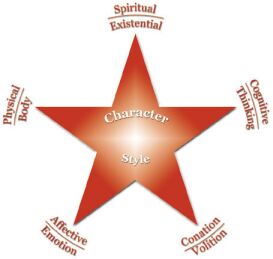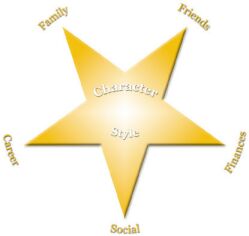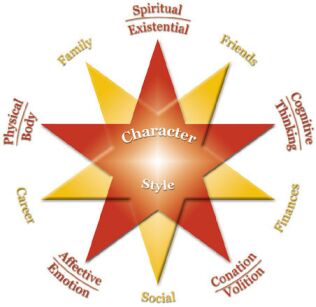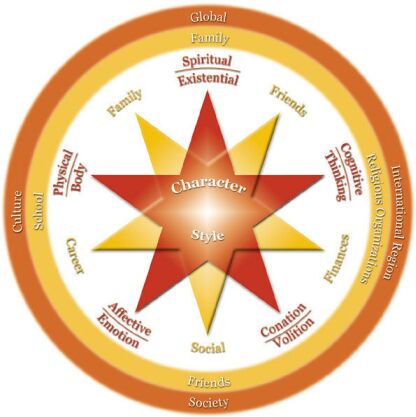|
Becoming a Brilliant Star |
|
Source:
Huitt, W. (1999). Becoming a Brilliant Star. Paper presented
at the Tenth Annual Youth-At-Risk Conference, Savannah, GA, March
1.
|
There is much discussion in education and psychology about the need to "develop the whole child." But what exactly does that mean? In order to answer that question one needs to have some view of the nature of a human being and the purpose of this life. The concept of "Becoming a Brilliant Star" is designed to address this issue as a guide to developing home- and school-based educational curricula for parents, educators, and others responsible for developing the qualities of children and youth. The basic philosophy stems from dynamical systems theory and the approach has been labeled "holistic formative education" to emphasize the need to focus more on the formative processes in each of the multiple domains of human development.
The Brilliant Star graphics shown below focus attention on three critical issues facing young people today: vision, character and competence. Vision has to do with dreams and goals of what is possible and desirable to do. Character deals with the habits or patterns of thinking, feeling, willing, and behaving that relate to right and wrong, to justice and equity, and to morality and ethics. Competence concerns the knowledge, values, attitudes, and skills that link to successful performance. All three issues are intertwined and difficult to isolate, although our experience suggests these can be observed separately in people.
The Brilliant Star is comprised of two core elements and ten domains. The two core elements are character and style and are foundational to development in the ten domains.. Style involves all of the personality, temperament, learning style, and other ways that help us define our uniqueness. Character refers to the underlying qualities of a person's moral or ethical knowledge, attitudes, values, and commitments that are systematically displayed in one's behavior. Character is associated with the quality of one's life, especially in terms of moral and ethical decisions and actions. The major distinction of character is that it is seen in one's behavior. One cannot rely exclusively on surveys or interviews, especially those related to hypothetical situations, to make statements about character. Data must come from actual behavior or, at a minimum, reports of actual behavior.
Of the ten domains, five are in essence more internal in that they relate to intrapersonal aspects of ourselves:
three faculties of mind traditionally identified in psychology

Five of the domains are more external in that they relate to more interpersonal aspects of human development:

It is in these ten domains that one is expected to develop competence. As previously stated, character and personal style are central (as indicated by their placement in the middle of the star) in that they influence learning and development in all domains. Vision relates to all ten domains and the two core elements in that one's ideas about possibilities and desires leads one to set goals and strive for excellence in each area.

Some synonyms for Brilliant Star as discussed here might be champion, spiritual or celestial warrior, hero, servant leader, or even giraffe (one who is willing to stick his or her neck out.) This is the opposite of someone who accepts being average or mediocre or sees himself or herself as a failure or loser.
It is important to acknowledge that the more internal domains of spiritual, physical, cognitive, affective and conative development are actualized in interaction with the more external domains of family, friends, career, finances, and social. For example, in early childhood one's understanding of family and the other external domains is heavily influenced by one's cognitive and emotional development. The reverse is also true; as one's development in the more external areas become more complex this can impact one's problem solving strategies and values system.
The Brilliant Star model also recognizes that the domains and core elements are developed in interaction with the more overarching influences (Bronfenbrenner, 1979). At the first level is the family, the school, the religious organizations, and friends or peer groups. At a more macro level, the influences include the culture, international region (such as NAFTA), and the global conditions.

Four fundamental principles guide the development of the Brilliant Star concept and the selection of materials shown below. First, human beings are considered as spiritual beings, a belief fundamental to all major world religions, as well as many philosophers and scientists (e.g. Templeton & Giniger, 1998). The sacred writings of the different faiths are an important source that we can use to develop the knowledge base for a vision of what excellence would look like in each domain. Philosophers have been discussing issues of spirituality from ancient times as exemplified in the writings of Socrates and Plato. And history has documented the success of many historical spiritual and religious figures. An immense amount of wisdom from these sources has been amassed over thousands of years of human history. Science is a relative newcomer to this process in that the writings of scientists span a little over a hundred years about what it means to be human. Despite the attempt to justify a totally materialist view of human beings by many scientists, important scientists such as Einstein and Jung have rejected this view.
A second, corollary principle is that no single source of knowledge about what it means to develop human potential should be used to define how to "Become A Brilliant Star." Science, religion, philosophy, history, literature, and the arts all have different standards by which to judge truth or the validity of concepts and principles. Each of these can provide standards by which we can judge alternatives of how to develop human potential. The small sampling of links to materials shown below demonstrates the unity, as well as the diversity, among different sources of information as it relates to human growth and development.
Third, the concept is being developed from a "systems" or "organismic" perspective. From this viewpoint, the individual is seen as a self-organizing system influencing and being influenced by the natural, social, and cultural contexts in which one lives. Bandura's (1986) concept of "reciprocal determinism" and Bronfenbrenner's (1979) concept of "the ecology of development" capture the idea that individuals both influence and are influenced by their environments. Sternberg's (1994) view that intelligence (or the capacity to learn) is shown when the individual is influenced by environment, when influencing the environment, or when selecting a more appropriate environment to meet one's needs or desires makes this same point. The systems view is compatible with the most modern of scientific paradigms (e.g., Capra, 1996) as well as several divine philosophies (e.g., De Chardin, 1989; Savi, 1989).
A fourth principle is that success in any venture is the result of first developing a vision of what is possible, developing written goals to achieve that desired outcome, taking action and measuring results, and finally, reflecting and making adjustments until desired results are achieved. The concept of W.Y.M.I.W.Y.G. (What You Measure Is What You Get; Hummel & Huitt, 1994) is central to this process. What you focus on through assessment and measurement becomes the end result you achieve, whether you had previously stated it or not or even if you had set some other result as a goal. Stated another way, we grow towards what we focus on. It is absolutely critical that we systematically assess our progress in assisting young people in their multidimensional growth process; otherwise we will simply continue to put energy into a single dimension such as academic achievement in basic skills as measured by standardized test scores. While this single measure might be important it does not capture the full-extent of what it means to be human or to fully develop one's capacities.
There are a variety of materials on this site related to developing vision and competence in each of these domains and core elements as well as on the conditions for that development. Selecting the appropriate term below will link to materials from religious scripture, philosophical discourse, individuals in history who have demonstrated excellence in a particular area, or writings from a perspective of science.
|
Spiritual
|
Physical
|
Cognitive
|
Affective
|
Conative
|
|
|
|
|
|
|
Family
|
Friends
|
Career
|
Financial
|
Social
|
|
|
|
|
|
|
Character |
Style | Culture | International Region | Global Conditions |
|
|
|
|
|
One can begin to work on "Becoming A Brilliant Star" right away. Download the Brilliant Star graphic (VEDI TEST) and assess yourself. The terms provided will help you identify where you are now in each dimension.
After you have drawn and colored your star ask yourself the following questions:
Decide where you are now and where you would like to be in each of these areas. Then select one or two areas for concentrated attention.
You might want to develop a mission statement as one way to help you think about your priorities. In addition, Waitley (1996) advises imagining what your life would be like if time and money were not an object in your life. That is, what would you do this week, this month, next month, if you had all the money and time you needed and were secure that both would be available again next year.
Next, set some one year goals and some immediate goals and write them down. Take some action everyday as you work to complete your goals. Develop an affirmation statement that you can repeat daily to help you stay on track. Make a checklist, start a journal, dialogue regularly with a mentor, or do something similar to hold yourself accountable to achieving your goals. You might also start each day with a "Thought for the Day" exercise that will help you focus on the qualities necessary to become a Brilliant Star.
As we start a new century, there is wide-spread belief that we must alter the schooling and education of our children and youth (Huitt, 1999). A variety of educational programs have been developed to address the important concerns of vision, character, and competence. One problem with most educational programs is that they focus on only one goal (e.g., high academic test scores or character development) to the exclusion of other important desired outcomes (e.g., emotional stability or self-regulation). Additionally, the foundation of the majority of these programs has been based on principles identified through philosophy or science. Unfortunately, many of these programs have been a disappointment to their founders. One reason may be that the programs were not founded on the best information provided through scientific investigation and research. However, another reason may be that the programs were founded ONLY on the principles of science. Fundamental truths offered by spiritual or religious teachings of the major world religions, philosophers, historical figures, authors, artists, or other important sources were perhaps ignored or not utilized. Since vision and morality are fundamental to all religious teachings, the omission of insights from religious scripture is likely significant. However, since science has discovered many principles related to learning and development that are not intuitively obvious (see Slavin, 2003), using only an alternative source such as religious scripture or philosophy and not using the scientific method to develop educational programs is equally difficult to justify.
The purpose of the materials at this site is to begin to remedy this deficiency. The materials are intended to be used to develop courses and programs of study that will allow the knowledge base developed through science (e.g., see Educational Psychology Interactive), religion, philosophy, and history to guide the holistic development of the education and training of young people.
References: